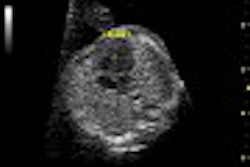(Ultrasound Review) Are small popliteal artery aneurysms significant? Vascular surgeons from Maimonides Medical Center in Brooklyn, NY recently investigated that question. According to the group, the treatment of asymptomatic smaller popliteal aneurysm remains controversial.
"We undertook this study to determine whether popliteal artery aneurysm diameter correlates with initial symptoms and presence of associated occlusive disease," they wrote.
Reported in the April issue of Journal of Vascular Surgery, their retrospective study determined "smaller popliteal artery aneurysm was associated with higher incidence of thrombosis, clinical symptoms, and distal occlusive disease."
Duplex ultrasound was performed in 500 patients prior to surgery and 34 popliteal aneurysms were discovered in 25 patients. "Fourteen patients (41%) had no symptoms and 20 (59%) had symptoms of severe claudication, acute ischemia, rest pain and tissue loss," according to the authors.
The patients were divided into two groups: Group I consisted of asymptomatic patients with suspected popliteal aneurysm, and Group II the symptomatic patients with suspected popliteal aneurysm. Average popliteal artery diameter was 2.8-cm for Group I and 2.2-cm for Group II.
"Our policy is to offer surgical repair as an alternative to observation alone for patients at low risk with patent popliteal aneurysms, regardless of the diameter," they said. An artery was considered aneurysmal when the diameter was 1.2-cm or larger, or more than 150% compared with the proximal vessel diameter. Aneurysms less than or equal to 2-cm were considered small. The distribution of popliteal aneurysm location was -- 50% above the knee, 44% at the knee, and 6% below the knee.
Previous research has recommended surgical intervention for aneurysms wider than 2-cm due to the risk of limb-threatening ischemia. However, other research showed a high rate of acute thrombosis in aneurysms averaging 1.8-cm, and this study supported that finding.
Surgical intervention for small aneurysms is considered appropriate by the authors when there is low operative risk, acceptable distal runoff, and a suitable venous conduit. Thrombosed popliteal aneurysms in asymptomatic patients are simply observed by these vascular surgeons.
Small popliteal artery aneurysms: are they clinically significant?Ascher, E., et. al.
Division of vascular surgery, department of surgery, Maimonides Medical Center, Brooklyn, NY
J Vasc Surg 2003 April; 37:755-760
By Ultrasound Review
July 30, 2003
Copyright © 2003 AuntMinnie.com



















